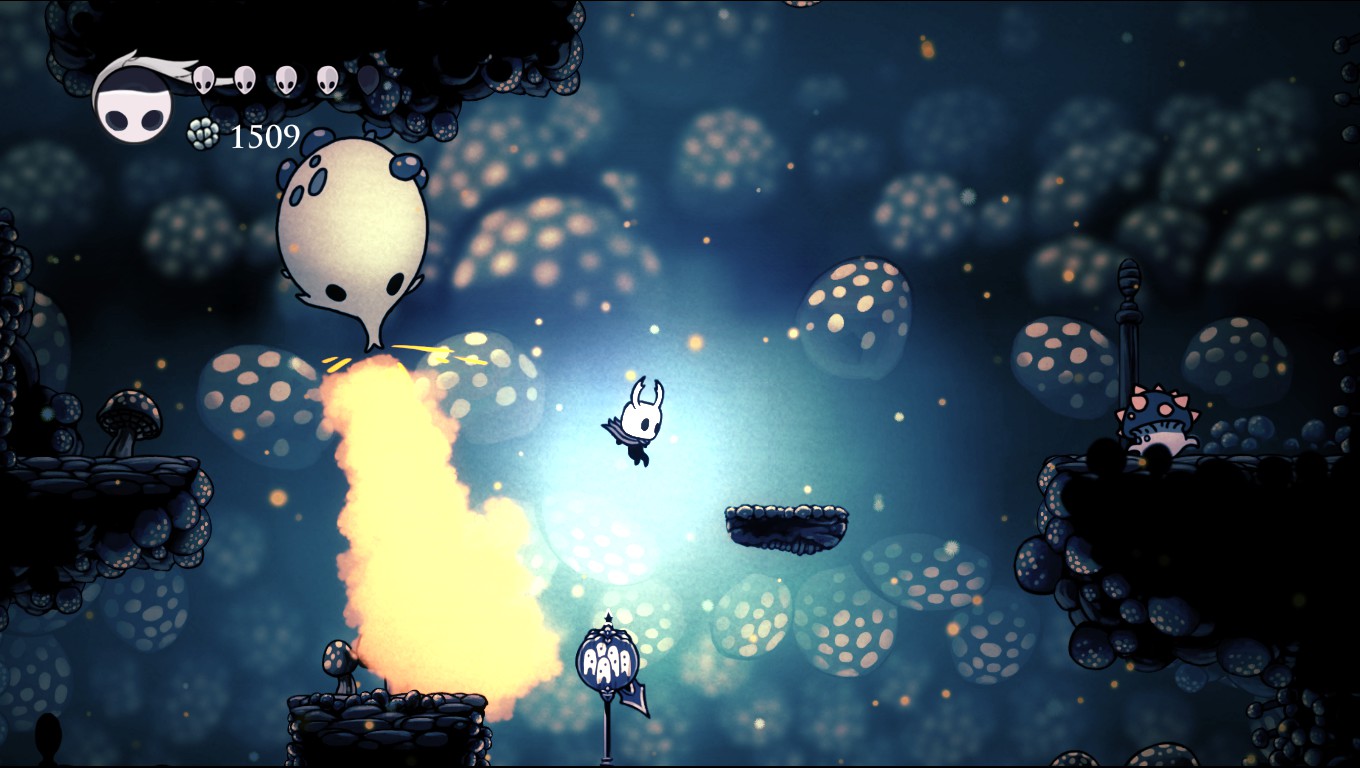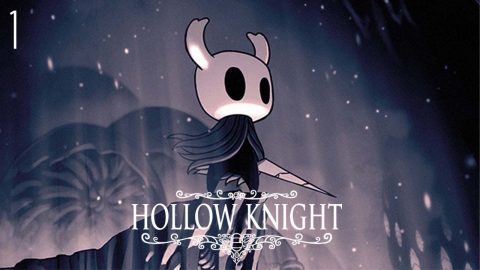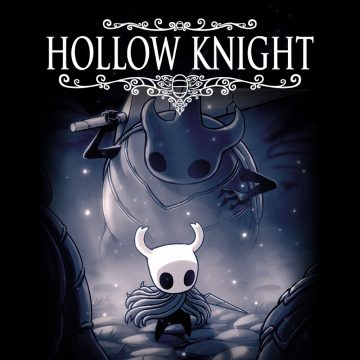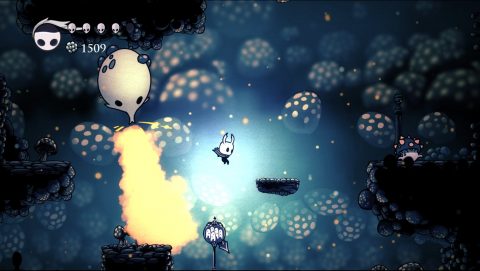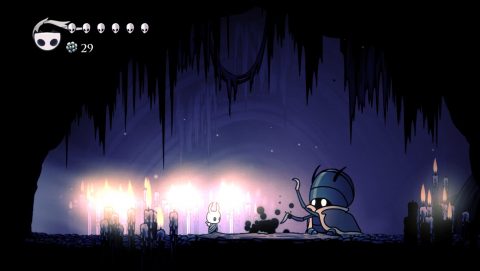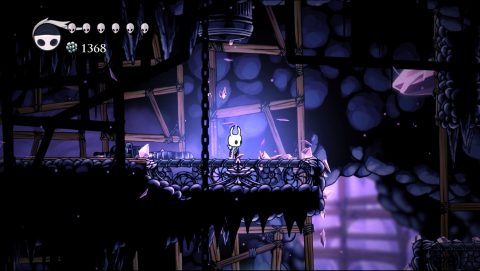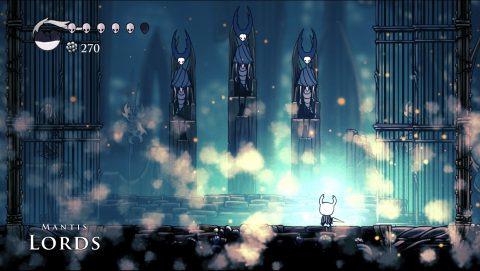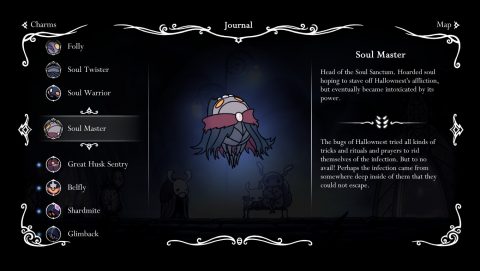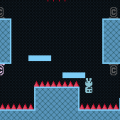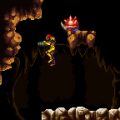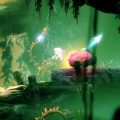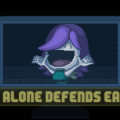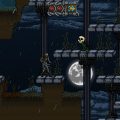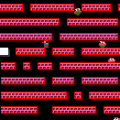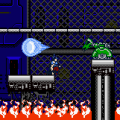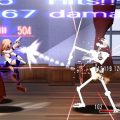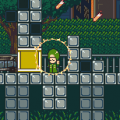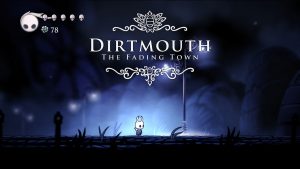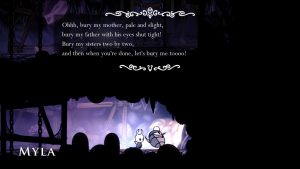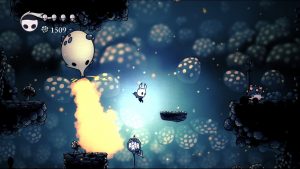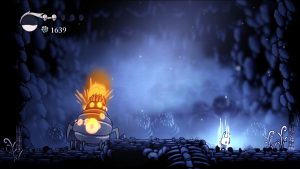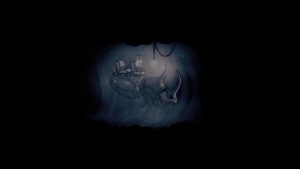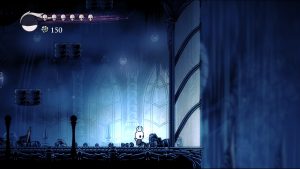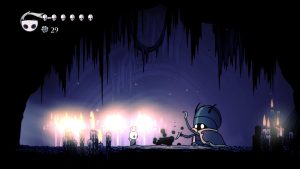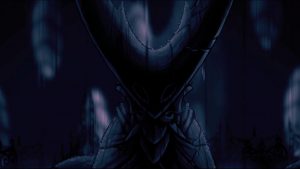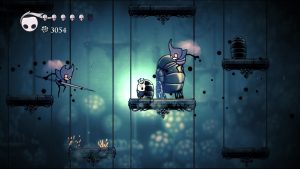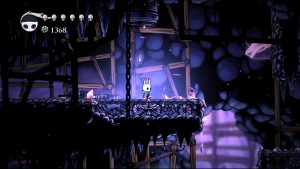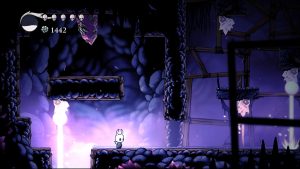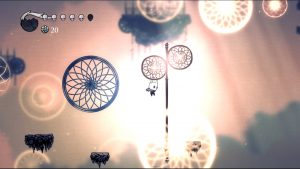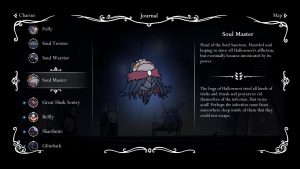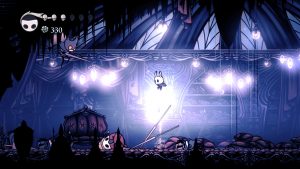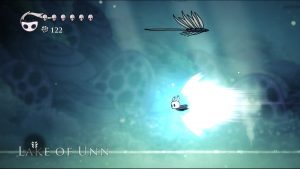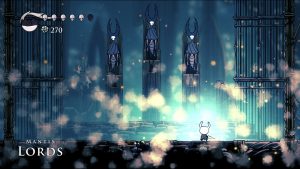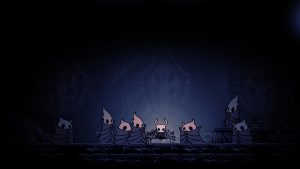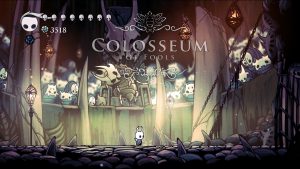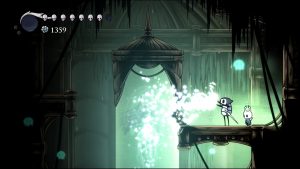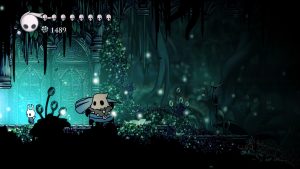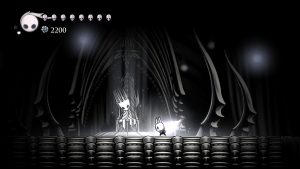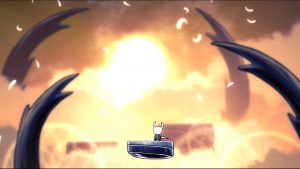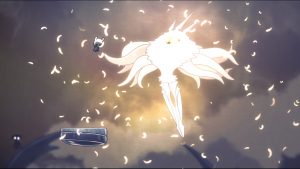Indie developers, due to the fact that they don’t respond to a corporate bureaucracy of an AAA studio, are able to experiment with the visuals, themes and mechanics of their games – and it’s certainly a good thing as it can lead to new and interesting games – or whole genres – we wouldn’t be able to imagine before (even if a big innovative indie success will inevitably lead to thousands of derivative indie copycats, as evidenced by the countless ‘pixel platformers’, ‘rogue-lites’ and ‘multiplayer survival games’ flooding Steam and other platforms). Despite that, it’s important to remember that experimentation and novelty isn’t the only thing that smaller, low-budget games are good at: sometimes, they’re just about taking already established genres and conventions that might not be given enough attention by the mainstream and doing them extremely well, giving the players exactly what they wanted.
Hollow Knight is one such game – it’s a metroidvania with a focus on exploration, a simple yet challenging combat, basic character building, platforming challenges based on timing and accuracy and an indirect narrative told less through dialog and cutscenes and more through visuals, level design and item descriptions. While a few of its ideas are more or less unusual (e.g. map mechanics, or the fact that all the characters are insects), it wouldn’t be too big of a stretch to describe it as a mixture of Super Metroid, Dark Souls and a few occasional bits of Super Meat Boy. What makes Hollow Knight work is that it absolutely nails most of this, and a few issues that it has pale in comparison to everything the game does right.
The game’s most obvious, readily visible strength, is its dedication to atmosphere. The game’s soundtrack is dominated by slow, minor-key compositions for piano and strings. The songs (from the melancholic title screen theme to the epic, tense and dissonant music of the final boss fights) stay with you long after you finish the game – but they’re also perfectly setting the mood for everything that happens during the game. The visuals do a great job of portraying a world that is a shadow of its former self – the impressive but overrun by hostile undead City of Tears with its architecture not unlike the XIX century neo-gothic style, the destroyed or unfinished infrastructure either reclaimed by nature in Greenpath or infested by monsters in Deepnest and the vast emptiness of Howling Cliffs all give the player a feeling of solitude inside the ruins of the world that once was. Those feelings are reinforced by gameplay – there’s few friendly NPCs to be found outside of Dirtmouth (a central hub, which the game describes as a ‘fading town’) and those who are there are often in direct and immediate danger, less friendly than they seem, insane, on a self-imposed exile, seeking death or just passing through on their quest for something greater. While the game is not without a sense of humor (e.g. anything involving the character of Zote the Mighty) and it does have a fair share of likeable characters, its mood is undeniably bleak.
The other great thing about Hollow Knight is exploration. Like in every game in the genre, we’re given a large, interconnected world in which some of the paths are blocked by obstacles which need to be bypassed through the use of unlockable abilities like double jump, wall jump or dash. There’s also plenty of Dark Souls-style shortcuts which can only be unlocked from one side but after that can be accessed from both. Thorough exploration is rewarded – the game features a lot of secrets, and many of them need to be found not only to get the best ending but also to understand the plot.
There’s an interesting twist on the automap mechanic which affects the exploration: you can’t access the map of an area until you buy it from an NPC. When you do buy it, it’s incomplete and the protagonist will only fill it in while resting on a bench (the game’s equivalent of a savepoint). This bring back the feeling of uncertainty from games like the first Metroid or Eternal Daughter, but without the frustration of having to keep your own hand-drawn maps or aimlessly looking for one specific place you have already visited ten hours ago when backtracking (and the game’s world is large enough for this to be a concern). Unfortunately, Hollow Knight simply doesn’t do enough with this: maps are cheap to buy and usually the NPC who sells them is fairly close to the entrance (I think there are only one or two levels in which you have to go without a map for an extended period of time). An early patch even added more obvious audiovisual cues which make finding the NPC easier, which suggests that the developers weren’t confident in this mechanic making the game better.
Hollow Knight is probably a bit more focused on combat than the usual Metroidvania. Fortunately, combat is also one of the game’s strengths. It’s nothing too complex: hitting enemies gives you mana which can then be used for healing, although healing takes time and leaves you defenseless. As the game goes on, you gain a few spells (activated with a simple combination of healing button and direction keys, drain some of your mana) and a few special melee attacks (which need to be charged) – but none of them are as universally useful as your character’s mobility. One of your best techniques is available immediately and it’s the one you may know from the NES platformer Duck Tales: jumping over your enemies, attacking downwards and bouncing into another jump. Combat in Hollow Knight is partially about patience and finding a good moment for an attack but it’s also about utilizing your platforming skills to avoid attacks and find weak spots (especially on enemies who defend themselves with shields). Spells might do a lot of damage to your foes but being able to recognize when and where to dash, jump and double jump in the heat of the battle is more important.
Platforming skills are important in combat but combat skills are also useful in platforming. Flying enemies will harass you when you’re near spikes or bottomless pits while the ability to bounce on them is useful for sequence breaking, occasionally needed to traverse tricky platforming sections and absolutely essential for the challenging optional area which needs to be beaten if you’re going for the best ending.
Speaking of the optional area, it is one of the game’s occasional tough platforming sections. They’re fairly similar to Super Meat Boy, although not as fast-paced: they’re short, they require pixel-perfect jumping and a really good timing. Unfortunately, the only way the game could get them right is by making the mechanics a little bit inconsistent: while getting hit by an enemy results in a bit of knockback, colliding with an environmental hazard makes the screen fade to black and teleports you to the nearest safe spot. This feels a bit off, but it’s probably the only way they could make it work without drastically redesigning those sections: making spikes and bottomless pits instantly lethal would result in a lot of frustrating backtracking (which may be par of the course for the usual metroidvania gameplay but would ruin the Meat Boy-style sections) and making them act the same way the enemy attacks do would make it trivial to tank through them provided you have enough health and mana (there’s also an optional item which makes your health regenerate which would remove any trace of challenge in such situation).
Character building in Hollow Knight is done pretty well. The game avoids the usual trap of introducing the so-called ‘RPG elements’ which don’t add much depth but force the player to grind for levels by repeating the same boring steps (e.g. fighting easy enemies). Upgrades to your weapon, health, mana and number of equippable charms can sometimes be found but usually need to be bought from NPCs – but getting enough of them not to be underpowered is not a big of a deal. More important than those ‘numerical’ upgrades, however, are charms. Those equippable items can be found or bought and they either provide a more meaningful ‘numerical’ upgrade or change some of the basic elements of gameplay: making it possible to keep steady while attacking, adding range (or even projectiles) to a melee attack, making health regenerate (or doing the opposite – giving you much more health but completely disabling healing) or making it possible to move while healing. The number of charms equipped at the same time is limited to it’s not possible to get every possible advantage (although it’s possible to equip slightly above the limit, for the price of taking twice the damage) and they can only be changed while resting so the player must commit to them for some time.
While the screenshots don’t do it justice, Hollow Knight is a great looking game. A large part of it is how well animated everything is. The sprites and the way they move are extremely expressive – and it is true not only for the friendly NPCs at Dirtmouth but also for your enemies. Just the way they move can be expression of anything from animalistic selfe-defense instincts to complete indifference and from insane, uncontrolled anger of the undead to cold, calculated tactics of experienced warriors. The game has a few really good looking cutscenes but I can’t help but be more impressed by the little scripted in-engine animations. The motions are fluid, but the animators also make a good use of quick cuts to indicate speed (this is especially apparent during some of the encounters with an important character called Hornet).
If there’s one complaint to be made about the game’s look, it has to be its reliance on blue and gray color palette, both for the environment and the NPCs. While not all the areas are like that, you’ll probably spend a lot of time in those that do. While it does fit the mood, it just becomes a bit monotone after a while.
The game’s relatively weak point is its plot – not because there’s something wrong with it but because it’s simply not the focus. Dark Souls is once again an obvious inspiration – not only is it told indirectly and many of the details are intentionally kept vague but it’s also a deconstruction of traditional myths and legends set in a decaying world during the end of an era. All the common elements are here: characters who gave up their ambitions due to apathy and resignation, former heroes driven insane (or otherwise incapable of controlling their actions), abandoned kingdoms, prophecies which may contain a hidden agenda, chosen ones who may not really be chosen after all and sacrifices which don’t work as expected. There’s a promising twist in the formula when the protagonist gains the ability to read minds, challenge the spirits of dead warriors and enter the dreams of certain NPCs but it ends up being more of a device than a fully developed fragment of game’s narrative: it delivers exposition (both lore for the world and background infromation about NPCs), additional combat and platforming challenges (a large number of which is required to unlock the best ending) and some appropriately dreamlike visuals, but it simply isn’t given enough attention in the story.
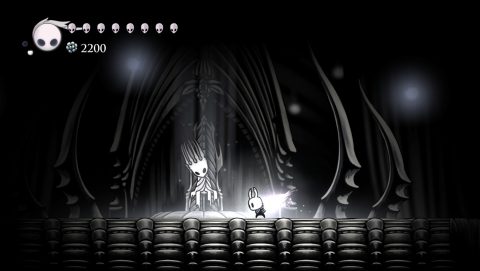 The most interesting parts of the game’s plot are those you experience near the end, but most of them won’t be seen unless you’re going for the best ending. At this point, the game starts dealing with the themes of individuality, free will and the relation between the creator and creation. As you uncover the past of Hallownest, Pale King, the original Hollow Knight and the mysterious Radiance. Parallels are drawn between the story of Radiance and bugs and the story of King and the vessels he created. The symbolism of light and darkness is flipped on its head. Of course, as per the convention, there doesn’t seem to be many definitive answers to the questions the game raises – but it’s interesting in spite (or maybe because) of that.
The most interesting parts of the game’s plot are those you experience near the end, but most of them won’t be seen unless you’re going for the best ending. At this point, the game starts dealing with the themes of individuality, free will and the relation between the creator and creation. As you uncover the past of Hallownest, Pale King, the original Hollow Knight and the mysterious Radiance. Parallels are drawn between the story of Radiance and bugs and the story of King and the vessels he created. The symbolism of light and darkness is flipped on its head. Of course, as per the convention, there doesn’t seem to be many definitive answers to the questions the game raises – but it’s interesting in spite (or maybe because) of that.
Hollow Knight is not revolutionary, but it doesn’t have to be. It’s a product of passion, and playing it makes it obvious what games the developers were passionate about. The passion behind Hollow Knight is the reason why it succeeds: it wouldn’t be this atmospheric if the creators didn’t sincerely try to make it emotionally resonant in its melancholy. It wouldn’t look and sound this good if not for deceptively simple but lovingly crafted sprites, amazing animation and unforgettable music. The passion can even be seen in the game’s business model: in the era of many unfinished or simply disappointing Kickstarter projects with big names and big money behind them, this game delivers a long, expansive campaign despite its fairly humble crowdfunded budget and a small price tag. As mobile-style microtransactions in AAA games become more common, Hollow Knight gives expansion packs,including Hidden Dreams and The Grimm Troupe, as free updates to everyone who bought the game. Team Cherry’s love for this game is obvious, and the game deserves an equal amount of love from the players.
